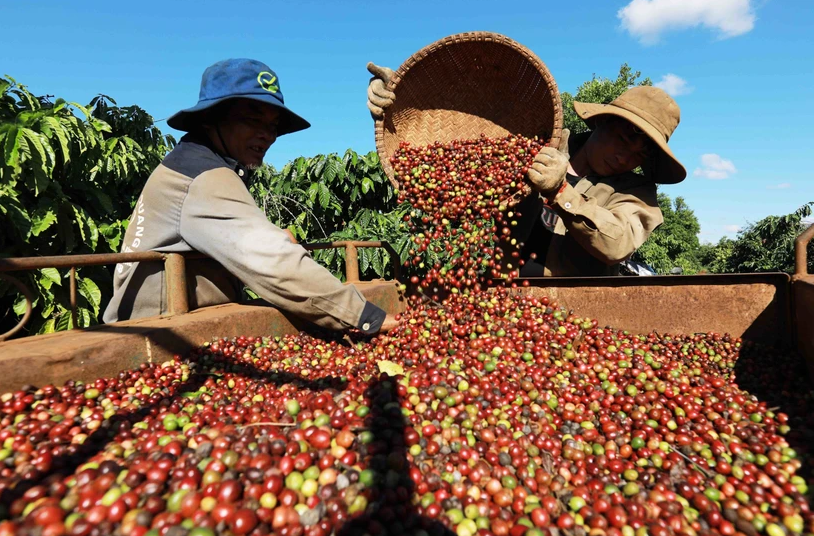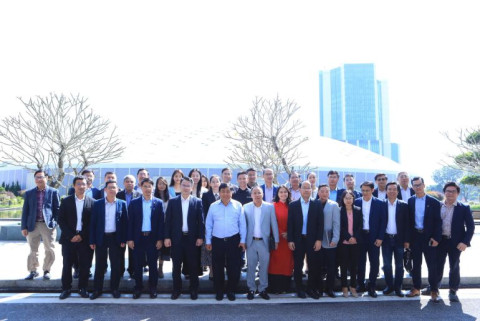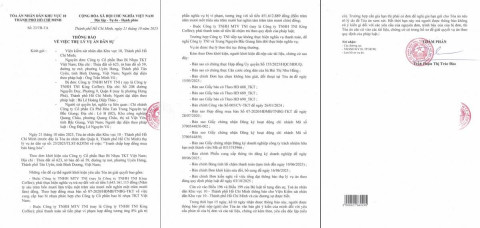Financial difficulties in the coffee sector in Binh Phuoc
- 136
- Business
- 17:53 22/04/2024
DNHN - Binh Phuoc, one of Vietnam’s key coffee-growing regions, plays a vital role in promoting agricultural development and creating jobs for local people.
One of the main factors affecting the financial situation of the Binh Phuoc coffee industry is coffee price fluctuations. Coffee prices are influenced by many global factors such as climate change, political tensions and economic policies. This volatility has a direct impact on the income and profits of coffee growers. In addition, the exchange rate between the Vietnamese đồng (VND) and the US dollar (USD) also plays an important role. Exchange rate fluctuations can affect coffee's export price and production materials' import price, thereby reducing growers' profits.

Inflation is also a significant challenge for the Binh Phuoc coffee industry. Inflation increases production costs due to higher prices for materials, labour and transportation, putting pressure on the profits of coffee growers. In addition, speculation in the coffee futures market can cause price fluctuations that do not reflect real supply and demand, affecting price forecasting and production planning for growers.
To overcome these financial challenges, Binh Phuoc coffee growers need to adopt effective financial solutions. The use of financial instruments such as futures contracts and options will help hedge against coffee price risk. In addition, interacting directly with the consumer market and cooperating with coffee exporters and roasters will help stabilise revenue and minimise price risk.
Adopting advanced farming techniques such as precision agriculture is also an important solution to improve coffee productivity and quality. At the same time, the use of modern processing and packaging technologies will help increase product value, creating opportunities for higher selling prices in the market.
The financial model of Binh Phuoc coffee trees includes inputs such as investment capital, labour and management costs; the production process from planting, care, and harvesting to processing; and the output is coffee products and revenue from the sale of products. Financial efficiency depends on coffee prices, productivity and production costs. Profit is calculated by subtracting production costs from revenue.
To assess financial performance, coffee growers need to rely on indicators such as profit, return on investment (ROI) and payback period. A thorough analysis and assessment of these factors will help coffee growers have an overview of the financial situation and make appropriate investment and production decisions.
Firstly, profit is an important indicator reflecting the profitability of the coffee industry. For Binh Phuoc coffee growers, profit comes not only from the sale of green coffee but also from by-products such as roasted coffee or instant coffee. To maximise profits, growers need to manage costs effectively, from production costs to operating and marketing costs.
Secondly, return on investment (ROI) measures the effectiveness of investing in the coffee industry compared to other industries. A high ROI indicates that the Binh Phuoc coffee industry has good profitability, attracting investment and expanding production. However, ROI also depends on global coffee price fluctuations and input costs such as plant varieties, fertilisers, and labour.
Thirdly, the payback period is the time it takes to recover the initial investment. In the coffee industry, this period can be long because coffee trees take time to develop and reach the harvesting stage. Investing in advanced technology and improving production processes can help shorten this period and increase competitiveness.
From this, we can see the impacts of market factors; Coffee prices fluctuate according to global supply and demand, influenced by factors such as weather, disease, and international trade policies. In which, investing in research and development of new coffee varieties, improving cultivation techniques, and applying information technology to monitor the market and manage risks.
Risk management takes advantage of derivative instruments such as futures contracts to hedge prices and minimise risks due to coffee price fluctuations. To achieve high financial efficiency, Binh Phuoc coffee growers need a comprehensive strategy that combines cost management, smart investment, and risk management. A deep understanding of the market and the ability to adapt to changes will determine the success of coffee growers in an increasingly competitive business environment.
Tran Tung
Related news
- From New Year messages of World Leaders to the “new rules” of the Global economy in 2026
- Connecting Leaders, Shaping the Future: Strategic Leadership Planning Meeting – CorporateConnections Hanoi A
- Sunlight - Unilever Vietnam Recognized for Outstanding Contributions to the National Initiative Supporting Women Entrepreneurs
- Deputy Prime Minister Nguyễn Chí Dũng: “The country’s major challenges weigh heavily on my mind — and we must resolve them together.
- Unitsky String Technologies signs cooperation agreements with three Vietnamese partners, opening a new direction for smart mobility and sustainable development
- When artists do business – livelihood is no poetry!
- Before the D‑day to abolish flat‑rate tax: Fear of technology and costs leave small traders struggling to adapt
- Vietnamese enterprises at a crossroads: the impact of a potential US–China deal
- "Digital technicians" must not be forgotten if Vietnam aims to meet its strategic goals
- HDBank: Impressive profit growth, leading in profitability and advancing international integration
- TNI King Coffee sued for over VND 5 Billion in unpaid debts
- VINASME and Jeonnam Technopark Sign MOU on technology cooperation, human resource training, and trade promotion
- Vietnamese entrepreneurs strengthen ASEAN connectivity in the digital iIntegration era
- Prime Minister: Vietnam aims to become a regional logistics hub
- Vietnam upgraded to Secondary Emerging Market by FTSE Russell
- Hanoi’s economy grows 7.92% in first nine months of 2025, FDI surges nearly threefold
- Vietnam’s strong gdp growth fails to ease labor market distress
- US tariffs on Brazil propel Vietnam’s pangasius into global spotlight
- VietLeap AI Accelerator launches: A strategic springboard for Vietnam’s AI startups
- CICON expands strategic alliances: A new step forward in Vietnam–Korea business connectivity
Đọc thêm Business
From New Year messages of World Leaders to the “new rules” of the Global economy in 2026
At a pivotal moment of transition, New Year messages from capitals such as Hanoi, Beijing, Washington and Paris reflect distinct priorities and strategic visions.
Connecting Leaders, Shaping the Future: Strategic Leadership Planning Meeting – CorporateConnections Hanoi A
"Your network is your most powerful flowing asset. It generates value, multiplies opportunities, and accelerates your influence across borders."
Innovative ESG enterprise: Trạm Xe Việt startup proposes solutions to build a green mobility ecosystem
As Vietnam commits to achieving Net Zero by 2050 and tightens emissions standards, the transportation sector faces unprecedented pressure to transform.
Deputy Prime Minister Nguyễn Chí Dũng: “The country’s major challenges weigh heavily on my mind — and we must resolve them together.
On the morning of November 26, 2025, Deputy Prime Minister Nguyễn Chí Dũng chaired a high-level working session at the National Innovation Center (NIC) in Hòa Lạc.
Unitsky String Technologies signs cooperation agreements with three Vietnamese partners, opening a new direction for smart mobility and sustainable development
The signing ceremony took place in Minsk, Belarus, on November 28, 2025.
Before the D‑day to abolish flat‑rate tax: Fear of technology and costs leave small traders struggling to adapt
From 1 January 2026 the flat‑rate tax regime will be abolished. Small business households will be required to declare tax based on actual revenue. MISA supports the transition with technology to help micro‑merchants adapt smoothly and transparently.
Vietnamese enterprises at a crossroads: the impact of a potential US–China deal
As the world closely monitors every shift in US-China relations, emerging signals of a strategic agreement between the two global powers are raising hopes for global economic stability.
HDBank: Impressive profit growth, leading in profitability and advancing international integration
Ho Chi Minh City Development Joint Stock Commercial Bank (HDBank, stock code HDB) announced its consolidated profit before tax for the first 9 months of 2025 reached VND 14,803 billion, marking a 17% increase year-on-year (YoY).
TNI King Coffee sued for over VND 5 Billion in unpaid debts
On October 21, 2025, the People’s Court of District 10 in Ho Chi Minh City officially accepted a civil lawsuit concerning a commercial contract dispute between TKT Vietnam Plastic Packaging Joint Stock Company and TNI King Coffee Co., Ltd.
VINASME and Jeonnam Technopark Sign MOU on technology cooperation, human resource training, and trade promotion
On October 15, 2025, in Hanoi, VINASME and Jeonnam Technopark (Korea) signed an MOU to promote trade, advance technology transfer, and develop human resources between enterprises of both nations.











